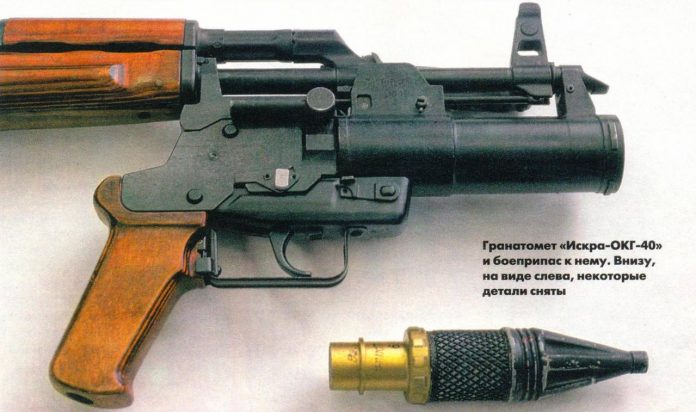
As is known, the world's first grenade launchers appeared only in the middle of the 60s of the last century. Superiority in this area belonged to the arms designers of the USSR and the USA. It was they who developed, manufactured and tested the first samples of promising weapons. Soviet "firstborn", anticipating the appearance of a whole line of infantry weapons, became a product called CER-40 "Iskra". It could not enter the arsenal of the Soviet army, but nevertheless gave a start to an important direction and influenced its further development.
The appearance of the grenade launcher Iskra was preceded by very interesting events.. AT 1963 year, a young employee of the Tula Central Design Bureau of Sports and Hunting Weapons Viktor Vasilievich Rebrikov, led by more experienced colleagues, began to develop a new model of infantry weapons. The aim of the project was to create a new rifle grenade., suitable for use with AKM. Similar systems existed in our army in the past., but later went out of use. For Kalashnikov assault rifles, such weapons were not created.
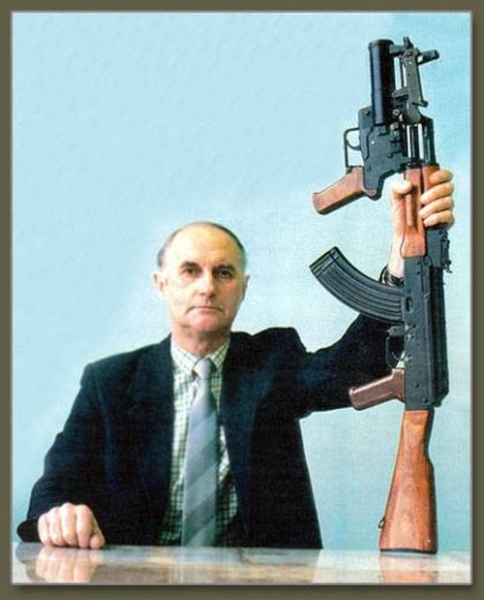 VV. Rebrikov and his OKG-40 grenade launcher.
VV. Rebrikov and his OKG-40 grenade launcher.
The designers counted, that installing a mortar mortar on the muzzle of the barrel will degrade the performance of the machine. Therefore, it was mounted under the trunk, on bayonet-knife mounts. At the same time, she had to be supplemented with a special muzzle and tube: their task was to transfer gases from the machine to the mortar. It soon became clear, that such a system will not be able to create sufficient gas pressure behind the grenade. It was proposed to use a grenade with its own propelling charge, and remove gases from the machine to the so-called. damper - device, converting pressure to blow on a grenade capsule.
Such a system turned out to be excessively complex and inconvenient to use.. Therefore, the designers decided to equip the mortar with their own trigger mechanism. With the help of the latter, it was planned to ignite the capsule and propellant charge of the grenade. So there was a modern concept of a grenade launcher.
For several reasons, work on mortars and grenades for AKM dragged on for several years. Only at the beginning 1966 years, the proposal was sent to the Main Rocket and Artillery Directorate. The military became interested in promising development and ordered to continue the development of the project. Besides, new weapons requirements were issued, tailored to the wishes of the army. The topic was assigned the code "Iskra", by which she subsequently gained fame.
It should be noted, that at the same time similar projects were created in the USA. AT 1963 Pentagon launched a light grenade launcher development program, fit for mounting on rifle XM16. Already in 1964, the Colt XM148 grenade launcher was developed, however, he was sent for testing only in late spring of next year. As far as, at the beginning 1966 years, Soviet and American engineers did not know about other people's developments and independently developed similar ideas.
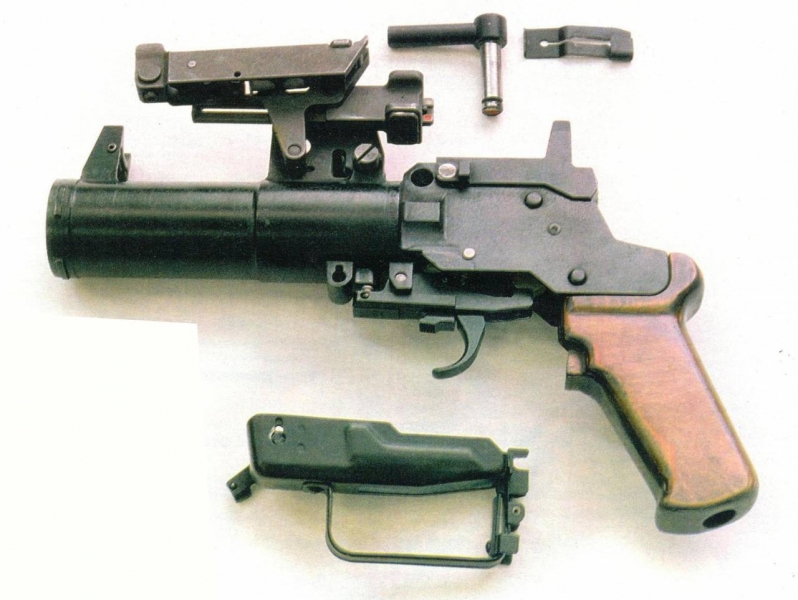 Experienced grenade launcher «spark». Trigger clip removed. Photo from the magazine «weapon»
Experienced grenade launcher «spark». Trigger clip removed. Photo from the magazine «weapon»
It was planned to develop two products within the framework of the Iskra. The first was the so-called. mortar to the machine under the designation TKB-048. She was personally occupied by V.V.. Rebrykov. Subsequently, the grenade launcher was assigned the designation OKG-40. TKB fragmentation-cumulative shot was intended for use with it-047, created by K.V.. Demidov. Alternative designation of grenades - OKV-40 (OKG-40 is also found).
In accordance with the requirements of GRAU, the designers had to create weapons of at least caliber 40 mm, capable of firing at distances from 50 to 400 m. With such a firing range, the Iskra was supposed to close the gap between the zones of destruction of hand grenades and mortar mines. Shot for TKB-048 it was proposed to equip fragmentation-cumulative warhead, what, as was expected, would allow attacking manpower and lightly armored enemy vehicles.
Ammunition TKB-047 was a unitary shot with a fragmentation-cumulative grenade. An explosive charge with a funnel was placed inside a cylindrical notched body, splinters. The front of the case was covered with a conical fairing with a fuse. Donets grenades were made in the form of a cover with a protruding lead belt. A sleeve of reduced diameter was connected to the bottom, containing propelling charge and capsule. Grenade Caliber - 43 mm.
A relatively large caliber led to, that the Iskra grenade launcher looked like a flare gun. He had a large trunk of significant external diameter, connected to the pistol frame, inside which there were elements of the trigger. On the upper surface of the barrel and frame were three elements of a special suspension system for installation on a serial machine.
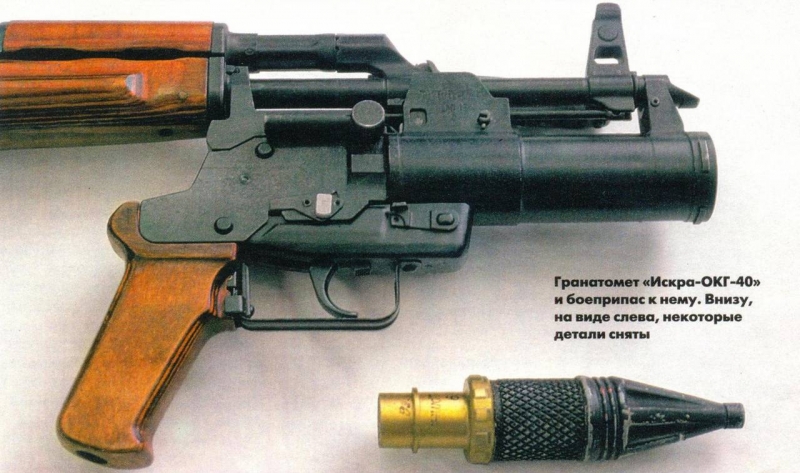 OKG-40 on AKM, used «unperturbing» suspension. Down below — grenade OKV-40. Photo from the magazine «weapon»
OKG-40 on AKM, used «unperturbing» suspension. Down below — grenade OKV-40. Photo from the magazine «weapon»
The grenade launcher was equipped with a 43-mm rifled barrel total length 140 mm. In its muzzle there was a narrow thickening, behind which was the base of the fly. The breech also reinforced, and on top of it is a suspension bracket. The barrel was mounted on the frame using detachable mounts, however, it should only be removed during maintenance. The weapon was muzzle-loading, and therefore retained its configuration throughout the entire cycle of preparation and shot.
The grenade launcher frame was a compact casing of complex shape, formed by intersecting surfaces. Front mounted to her trunk, a separate casing with a protective bracket was installed from below. Behind it was a wooden handle, made as an independent part. The internal volume of the frame contained the details of the trigger.
Fire control was carried out using a pistol grip and a traditional trigger. Pressing the trigger releases the hammer, piercing capsule. For safe handling, the grenade launcher had a non-automatic fuse. In case of shooting with large elevation angles, the weapon was equipped with a special device. It was supposed to bleed some of the powder gases out, reducing the initial grenade speed. calculations showed, that at a normal initial speed and a large elevation angle, the grenade will remain in the air until 12-14 seconds. During this time, the wind could blow it off the desired path. Gas bleeding and speed reduction allowed to reduce the flight time of the grenade to an acceptable level.
The first version of the Iskra had a rigid mount for mounting on the barrel. A ring was put on the muzzle, and on the mount for the bayonet was a lock, grenade launcher. In the course of testing, such a fastener most clearly demonstrated its failure, as a result, I had to create a new system.
 OKV-40 fragmentation-cumulative shot.
OKV-40 fragmentation-cumulative shot.
Soon, the so-called. non-disturbing suspension, eliminating the negative impact of the grenade launcher on the machine. On the breech of the barrel grenade launcher, from above, a bracket with a clamp was provided. It was mounted on a standard mount for a bayonet-knife. Undesirable movements of the mortar grenade launcher in the vertical plane were eliminated with a pair of additional stops, placed over the barrel and at the back of the frame.
This mount was tough enough, but at the same time it did not allow excessive impact of recoil on the machine. Besides, the muzzle of the grenade launcher almost did not protrude before the muzzle of the main weapon. This was to facilitate the operation of the automatic grenade launcher system., and also allowed the development of over-caliber grenades.
For obvious reasons,, TKB-048 / OKG-40 could not use the machine’s standard sights for firing. On the left surface of the bracket bracket located swinging bar sight. Its different positions corresponded to different elevation angles, necessary for firing at certain ranges.
The total length of the new grenade launcher did not exceed 300 mm at a height of the order 200 mm. Weight without grenade - 1,15 kg. A relatively short barrel did not allow to obtain high initial velocity. So, when the crane device was open and the gases were discharged, this parameter reached everything 55 m / s. When closed, increased to 65-70 m / s. With the crane open and with maximum elevation angles it was suggested to shoot at a distance 60-80 m; over long distances it was necessary to shoot with a closed crane and on more gentle paths. Maximum range, estimated, corresponded to the technical specifications.
From a certain time, the TsKIB SOO employees began to develop the basic ideas of the V.V.. Rebrikova and prepared some interesting suggestions. So, an unusual way to expand the range of ammunition was proposed. It turned, that OKG-40 can use a PG-7V over-caliber shot from an RPG-7 rocket launcher. To the head of such a grenade should be attached a new sleeve with a propelling charge, after which the firepower of the automatic grenade launcher system grew at times. However, this could also reduce weapon usability dramatically.
 Experienced automatic grenade launcher system consisting of AKM and OKG-40.
Experienced automatic grenade launcher system consisting of AKM and OKG-40.
The second original proposal was implemented in the TKB project-049 "Torch". Designer VN. Teles developed a silent firing device, compatible with Iskra. Unfortunately, no details for this project. Design and function, as well as the real effect of such a device is unknown.
More modest, but noticeable results were obtained in the draft TKB-048M. This version of the grenade launcher almost completely repeated the basic, but different from her in terms of technology. Most of the details of the Iskra version of M were cast, which gave some advantages in terms of mass production.
In the late sixties, Tula gunsmiths made prototypes of grenade launchers / mortar TKB-048 and TKB-048M, as well as a supply of fragmentation-cumulative grenades for them. The tests were carried out as in a dash., and at open ranges. Noteworthy results were obtained over the course of sufficiently lengthy checks.. The grenade launcher met the basic requirements for range and accuracy, although it was not without problems.
The very first shot of Iskra, equipped with rigid mounts for the machine, turned out to be not the most successful. Grenade left the trunk, but from the recoil the machine received serious damage. The barrel bent over the barrel, and the gas chamber fell apart at the seams. The designers had to urgently rework the fasteners: they abandoned the rigid connection of the gimbal and the barrel. After this, the tests continued without damage to the material..
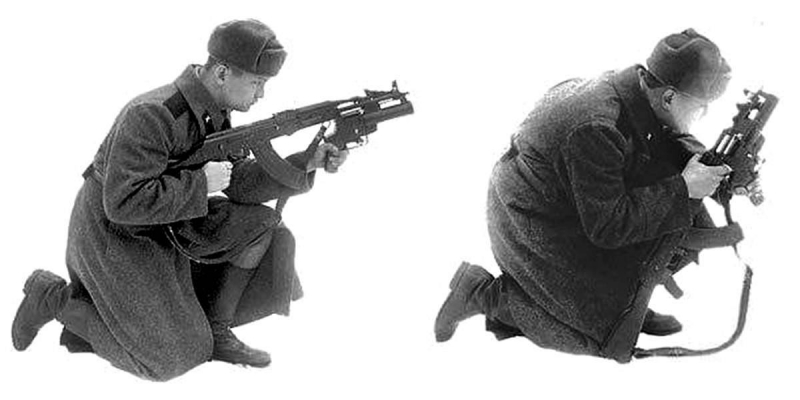 Shooting from a grenade launcher «spark».
Shooting from a grenade launcher «spark».
Later there was a curious incident.. In a closed shooting range, in the presence of GRAU representatives, two shots were successively fired at a sporting target at a distance 25 m. After the second shot, the testers and the military saw, that there is still only one hole in the target. It turned, that both grenades hit one point. It is unlikely that this episode met the requirements of the army for testing., but still he demonstrated certain qualities of a weapon. In the course of more serious tests, it was possible to confirm the calculated characteristics of the range and accuracy of the fire.
However, problems with the existing ammunition were revealed in parallel. TKB fragmentation-cumulative grenade-047 / OKV-40 in ideal conditions, at a meeting angle of 90 °, could break through 50 gomogennoy booking. However, increasing the angle sharply reduced the potential of the grenade. So, 30-mm armor plate at an angle of 45 ° managed to break through less 60% grenades issued. Increasing the thickness of the armor or the angle of its inclination rather quickly made the grenade useless. Besides, splinters, formed by crushing the hull, had insufficient destructive power. During the tests, it was also found, that some design options for the grenade were unsuccessful. Due to improper aerodynamics, they spun in flight, because of what could fall on the target sideways or bottom, which excluded the fuse actuation.
Despite the identified shortcomings, in summer 1970 years experienced "Sparks" and shots for them were sent to the Rzhev training ground for testing by army specialists. The next stage of inspections ended with similar results.. Testers noted as benefits, and the disadvantages of the new weapon. Besides, new specific problems were identified, associated with the operation of the grenade launcher in the field.
It should be noted, that not the most pleasant things are known from the memories of the project participants. Since the inception of the original concept, there have been debates about its necessity., and in addition, the project constantly faced bureaucratic problems. Finally, there was personal rejection of the project by some responsible persons. How exactly such factors affected the development and test results is anyone's guess..
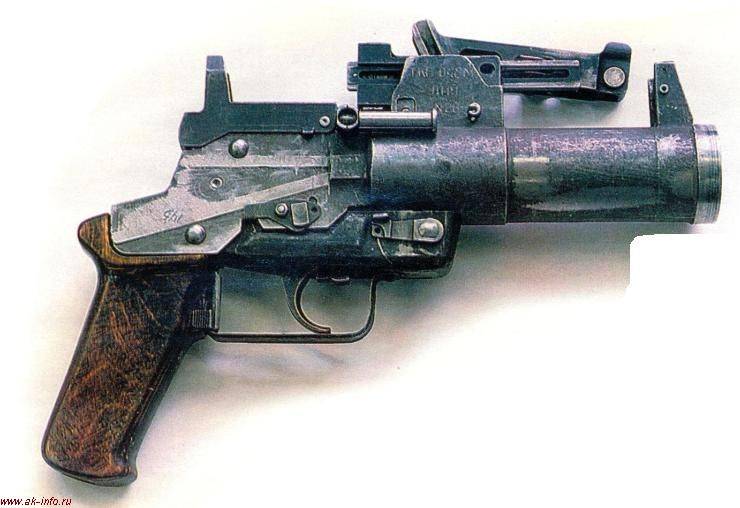 Updated version «spark» — TKB product-048M. Photo Ak-info.ru
Updated version «spark» — TKB product-048M. Photo Ak-info.ru
Nevertheless, according to the test results, it was nevertheless decided to stop work. Documentation went to the archive, and assembled grenade launchers of two types - to the warehouse. However, they didn't have to lie idle for long. New checks soon started.
Around the same period, Soviet military specialists brought a foreign novelty from Vietnam - an American automatic grenade launcher system consisting of an M16 rifle and an XM148 grenade launcher.. These products, already reached the battlefield, interested the Soviet military, and they remembered about the domestic development of the same class. In the shortest possible time, comparative tests of two domestic samples were organized..
To test and demonstrate capabilities, the OKG-40 product and the newest TKB grenade launcher were sent to the Rzhevka test site.-0121 development of V.N.. Telesh. Iskra again showed ambiguous characteristics, whereas the results of the newer TKB-0121 considered promising. Comparison, TKB-047 sent to the warehouse again, and the grenade launcher VN. Telesha got the green light. This design was modified as part of the ROC "Koster", which led to the appearance of the GP-25 grenade launcher, adopted at the end of the seventies.
The first in the Soviet - or even in the world - practice under-barrel grenade launcher, capable of turning an assault rifle into a rifle complex with increased characteristics, did not cope with the tests. Specific requirements were imposed on him, and it was not possible to fully fulfill them. Nevertheless, ideas, laid down in the Iskra project, turned out to be successful. Several years later, they were successfully implemented in the new project GP-25 "Koster". This sample turned out to be so successful., which has been in service for four decades, and in the past he himself became the basis for new weapons.










